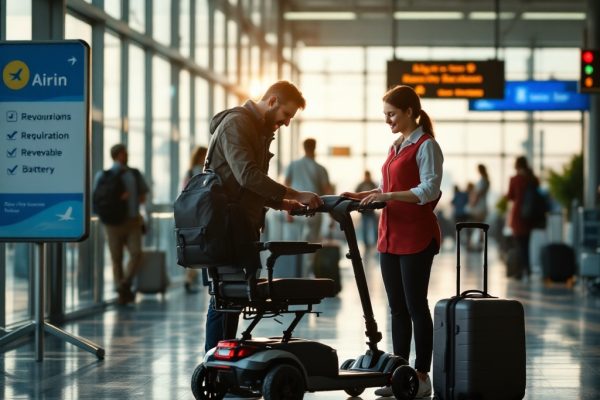High Blood Pressure and Air Travel: What You Should Know
Planning a flight with high blood pressure? Air travel with hypertension (over 130/80 mm Hg) requires careful preparation. While generally safe with proper management, understanding the impact of altitude and potential risks like blood clots is crucial. Discover essential tips for a healthy flight, from pre-flight consultations with your doctor to in-flight hydration and exercise. Learn how to monitor your blood pressure and manage potential complications. Ensure a safe and comfortable journey by reading more now.
Important information

- Consult your doctor before flying, especially if your blood pressure is above 130/80 mmHg or not well-controlled. Discuss potential risks and necessary medication adjustments.
- Monitor your blood pressure during the flight and stay hydrated by drinking plenty of water.
- Walk around the cabin periodically to improve circulation and reduce the risk of blood clots.
- Avoid excessive alcohol and caffeine consumption, as these can dehydrate you and affect blood pressure.
- If your blood pressure is 180/100 mmHg or higher, consult your doctor before flying, as it may pose significant health risks.
High Blood Pressure and Air Travel: Key Considerations
Traveling by air with high blood pressure (over 130/80 mm Hg) requires careful consideration. While most individuals with well-controlled hypertension can fly safely, consulting your doctor beforehand is essential. This discussion should cover potential risks, medication adjustments needed for travel, and the impact of altitude on blood pressure. During the flight, remember to monitor your blood pressure, stay hydrated, and take occasional walks in the cabin to mitigate potential issues.
Consult your doctor. Discuss potential risks, medication adjustments, and the impact of altitude on your blood pressure.
Monitor your blood pressure during the flight.
Stay hydrated by drinking plenty of water.
Take occasional walks in the cabin.
Impact of High Blood Pressure on Air Travel
High blood pressure increases the risk of heart attacks and strokes, and air travel can worsen these risks due to lower oxygen levels and cabin pressure changes. Flying can also increase your risk of developing deep vein thrombosis (DVT), mainly caused by prolonged sitting.
Risks and Complications of Flying with High Blood Pressure
Traveling by air can pose health risks for individuals with high blood pressure, including blood clots, heart attacks, and strokes. The stress of travel, dehydration, and changes in altitude can elevate blood pressure, increasing these risks, especially for those with severe hypertension. However, most people with high blood pressure can fly safely with proper management. Staying hydrated is crucial, and consulting your doctor before flying is highly recommended, particularly if your blood pressure is not well controlled.
Potential Health Risks
Air travel can pose a blood clot risk for those with high blood pressure due to lower oxygen levels at altitude. This reduced oxygen can also exacerbate breathing difficulties, particularly for individuals with pre-existing respiratory conditions. Fortunately, simple measures like staying hydrated and walking around the cabin can help mitigate these risks. Passengers, especially those with underlying health concerns, should consult their doctor before flying. With proper preparation, air travel can be safe despite these potential challenges.
Altitude Effects on Blood Pressure
High altitude affects blood pressure due to reduced blood oxygen levels. The lower cabin pressure in airplanes, equivalent to altitudes of 6,000 to 8,000 feet, can increase both heart rate and blood pressure, particularly for those with pre-existing hypertension.
Passengers managing their hypertension with medication are less prone to serious complications. Despite this, monitoring blood pressure during flights is advisable for anyone with concerns.
Dehydration and Its Impact
Staying well-hydrated is key to maintaining healthy blood pressure, especially during air travel. Dehydration can cause blood pressure to rise, so drinking plenty of water while flying helps prevent those spikes and keeps your levels stable.
When Not to Fly: Understanding Unsafe Blood Pressure Levels
Traveling by air with high blood pressure requires some precautions. If your blood pressure is 180/100 mmHg or higher, consult your doctor before flying. This consultation is crucial for ensuring a safe and healthy trip.
Critical Blood Pressure Readings
Traveling with severely high blood pressure (180/110 mmHg or higher) can be risky. At these levels, flying increases the chances of serious cardiovascular events, such as strokes and heart attacks. If you have hypertension, monitor your blood pressure regularly, especially before and during air travel. Consult your doctor before flying if your blood pressure is elevated.
Managing Blood Pressure for Safe Air Travel
Managing your blood pressure is crucial for a safe and comfortable flight. Follow these recommendations:
- Adhere to your prescribed medication regimen.
- Stay well-hydrated by drinking plenty of water.
- Limit alcohol and caffeine intake.
- Perform gentle in-flight exercises, such as walking around the cabin, to promote healthy circulation.
- Check your blood pressure before and after your journey.
Importance of Blood Pressure Control
Managing your blood pressure is essential for healthy air travel. Before your flight, consult your doctor to ensure it’s well-controlled. Regular checkups are vital, especially for those with hypertension, to minimize potential health risks during travel.
Consulting a Healthcare Provider
Before flying with high blood pressure, consult your doctor. They can assess your health and discuss potential air travel risks. Your doctor can determine if your blood pressure is at a safe level for flying. They may also suggest precautions like wearing compression stockings or advise on managing in-flight stress. Your doctor will provide personalized recommendations to ensure your safety and well-being during your travels.
Precautionary Measures for Flying with High Blood Pressure
Consult your doctor before your flight, especially if you have any health concerns.
Keep essential medications in your carry-on for easy access.
Staying hydrated is crucial, so drink plenty of water throughout your journey.
Skip the alcohol and caffeine, as these can dehydrate you.
Take regular walks around the cabin to improve circulation and comfort.
Pre-Flight Preparations
Traveling with high blood pressure requires careful planning. Before your trip, consult your doctor, especially if you have concerns about your blood pressure. Pack sufficient medication in your carry-on bag to last beyond your intended travel duration, accounting for potential delays. Monitor your blood pressure regularly before and during your trip. Stay hydrated by drinking plenty of water and limit your intake of alcohol, caffeine, and salty foods, as these can elevate blood pressure. Manage stress through relaxation techniques such as deep breathing or meditation. Engage in light exercise during your trip but avoid strenuous activities.
Tips for Flying Safely
Stay hydrated for a comfortable flight. Drink plenty of water before, during, and after your journey.
Improve circulation by regularly moving your legs and feet during the flight. This simple activity can significantly enhance your comfort.
Avoid excessive alcohol and caffeine. These beverages can dehydrate you, making your flight less pleasant.
Consult your doctor before flying if you have blood pressure concerns. Taking this precaution is essential for your well-being.
Pack essential medications in your carry-on bag. Never pack essential medications in checked luggage to ensure you have access to them throughout your journey.









